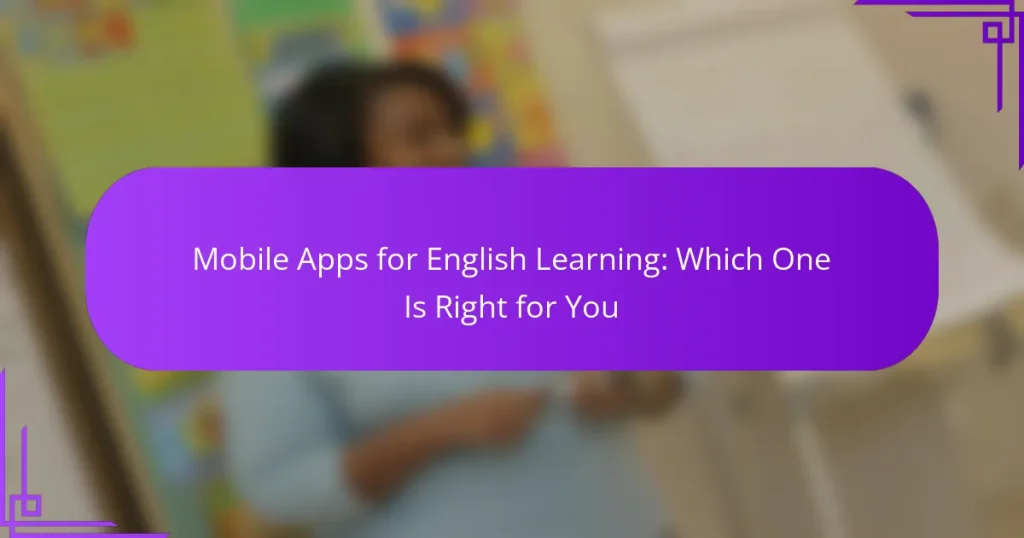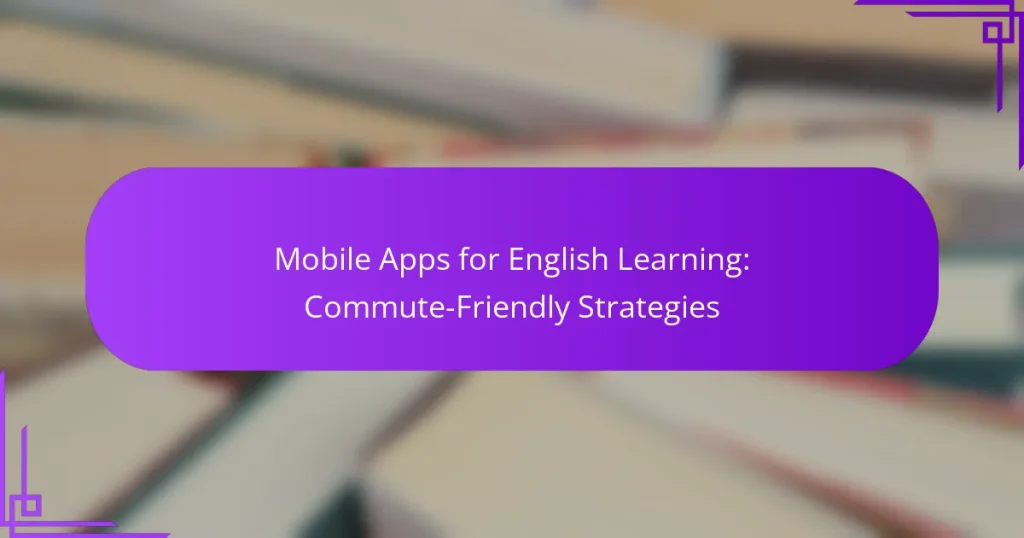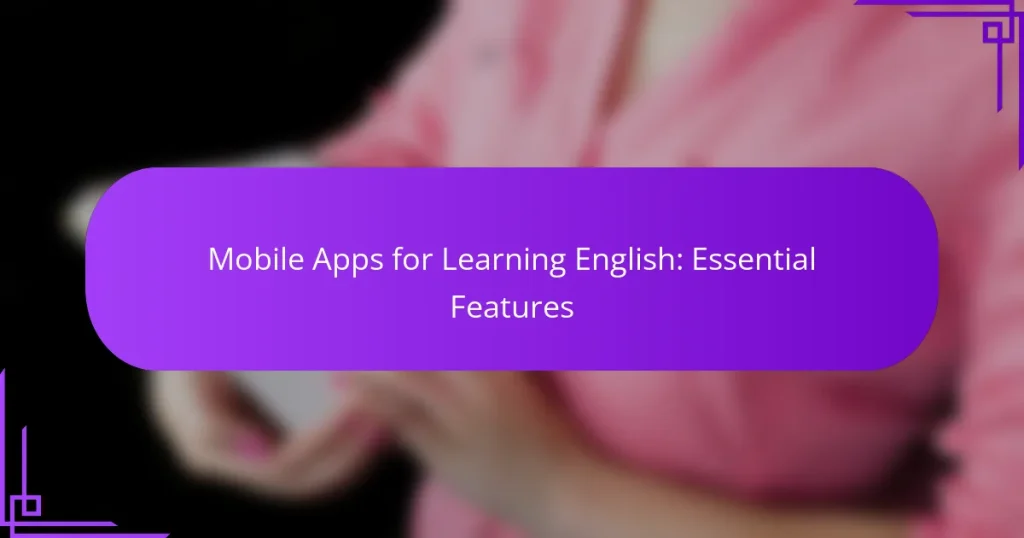Mobile apps have revolutionized the way we learn English, offering interactive and personalized experiences that cater to individual learning styles. Popular options like Duolingo, Babbel, and Rosetta Stone provide diverse methods such as exercises, games, and audio from native speakers to enhance language acquisition. When selecting an app, consider features that promote engagement and track your progress for optimal results.
Mobile Apps for English Learning: Which One Is Right for You
Mobile Apps for English Learning: Progress Tracking Methods
Mobile Apps for Learning English: Effective Grammar Tools
Mobile Apps for English Learning: Commute-Friendly Strategies
Mobile Apps for Learning English: Essential Features
Mobile Apps for Learning English: User Experience Insights
What are the best mobile apps for learning English?
The best mobile apps for learning English include Duolingo, Babbel, Rosetta Stone, Busuu, and Memrise. Each app offers unique features and approaches to help users improve their language skills effectively.
Duolingo
Duolingo is a popular language-learning app that uses gamification to engage users. It offers bite-sized lessons that cover vocabulary, grammar, and pronunciation through interactive exercises.
One of its strengths is the ability to track progress and earn rewards, which keeps learners motivated. The app is free to use, but a premium version is available for an ad-free experience and additional features.
Babbel
Babbel focuses on conversational skills and real-life dialogues, making it suitable for users who want to speak English confidently. Lessons are designed by language experts and cover a wide range of topics.
While Babbel requires a subscription, it often provides discounts for longer commitments. Users appreciate its structured approach, which is ideal for beginners and intermediate learners.
Rosetta Stone
Rosetta Stone is known for its immersive method, emphasizing learning through context rather than translation. This approach helps learners think directly in English, enhancing fluency.
The app includes speech recognition technology to improve pronunciation. It is subscription-based, with options for monthly or annual plans, making it a long-term investment in language skills.
Busuu
Busuu offers a community-driven approach, allowing users to practice with native speakers. It features interactive lessons and personalized feedback, which can significantly enhance learning outcomes.
With a free version available, users can access basic features, while a premium subscription unlocks advanced content and offline access. This flexibility makes it appealing for various learning styles.
Memrise
Memrise utilizes spaced repetition and mnemonic techniques to help users memorize vocabulary effectively. Its engaging content includes videos of native speakers, which aids in understanding pronunciation and context.
The app is free with optional premium features, such as offline access and additional learning tools. Memrise is particularly beneficial for learners who thrive on visual and auditory cues.
How do mobile apps enhance English learning?
Mobile apps significantly enhance English learning by providing interactive and engaging experiences tailored to individual needs. They leverage technology to create immersive environments that facilitate language acquisition through various methods such as exercises, games, and personalized content.
Interactive exercises
Interactive exercises in mobile apps allow learners to practice English skills actively rather than passively. These exercises often include quizzes, fill-in-the-blank activities, and listening comprehension tasks that adapt to the user’s proficiency level.
For example, apps may offer vocabulary drills that adjust difficulty based on user performance, ensuring that learners are consistently challenged without becoming overwhelmed. Regular practice through these exercises can lead to improved retention and understanding of the language.
Gamification elements
Gamification elements in language learning apps make the process enjoyable and motivating. Features such as points, badges, and leaderboards encourage users to engage more frequently and compete with peers, fostering a sense of achievement.
Many apps incorporate game-like scenarios where users can complete missions or challenges related to real-life situations, enhancing practical language use. This approach not only makes learning fun but also helps in maintaining user interest over time.
Personalized learning paths
Personalized learning paths in mobile apps cater to the unique needs and goals of each learner. By assessing initial proficiency and preferences, these apps can create customized curricula that focus on specific areas such as grammar, vocabulary, or speaking skills.
For instance, a user aiming to improve conversational skills might receive targeted exercises that emphasize speaking and listening, while another focusing on writing may engage with different types of prompts. This tailored approach ensures that learners can progress at their own pace, maximizing their learning outcomes.
What features should I look for in English learning apps?
When choosing English learning apps, prioritize features that enhance your learning experience and engagement. Look for tools that incorporate speech recognition, progress tracking, and native speaker audio to ensure effective practice and improvement.
Speech recognition technology
Speech recognition technology allows learners to practice pronunciation by comparing their speech to native speakers. This feature can provide instant feedback, helping users identify and correct mistakes in real-time. Apps with advanced algorithms can analyze pronunciation accuracy and suggest improvements.
When selecting an app, consider how well the speech recognition works in various accents and dialects. A good app should support multiple English varieties, such as American, British, or Australian English, catering to diverse learning preferences.
Progress tracking
Progress tracking features help learners monitor their advancement over time, providing insights into strengths and areas needing improvement. Look for apps that offer visual representations of your progress, such as graphs or badges, to keep you motivated and engaged.
Some apps allow you to set specific goals, such as daily practice time or vocabulary targets. This can create a structured learning path and encourage consistent practice, which is crucial for language acquisition.
Native speaker audio
Native speaker audio is essential for developing listening skills and understanding natural speech patterns. Apps that include a variety of audio clips from different speakers can expose learners to various accents and colloquial expressions, enriching their language experience.
Choose apps that provide context for the audio, such as dialogues or situational conversations, to enhance comprehension. Listening to native speakers in real-life scenarios can significantly improve your ability to communicate effectively in English.
How much do mobile apps for learning English cost?
Mobile apps for learning English can range from free to several hundred dollars, depending on the features and model. Users should consider their learning goals and budget when selecting an app, as costs can vary significantly based on the type of access and content offered.
Free vs. premium models
Free models typically offer basic features, allowing users to access limited content without any cost. These apps may include ads or restrict certain functionalities, pushing users towards premium versions for a fuller experience.
Premium models usually require an upfront payment or a subscription fee, providing enhanced features such as offline access, personalized learning paths, and ad-free experiences. Users should weigh the benefits of these additional features against their learning needs.
Subscription pricing
Subscription pricing for English learning apps often ranges from around $5 to $30 per month, depending on the app’s offerings. Some platforms provide discounts for annual subscriptions, making it more economical for long-term users.
When considering subscription options, look for trial periods that allow you to evaluate the app’s effectiveness before committing. This can help ensure that the app aligns with your learning style and goals.
In-app purchases
In-app purchases can enhance the learning experience by unlocking additional content, features, or tools within a free or premium app. Common examples include specialized courses, practice exercises, or advanced grammar lessons.
Be cautious with in-app purchases, as they can accumulate quickly. Set a budget for these extras and prioritize purchases that directly support your learning objectives to avoid overspending.
What are the pros and cons of using mobile apps for English learning?
Mobile apps for learning English offer flexibility and a variety of resources, but they can also lead to distractions and a lack of structured learning. Users should weigh these advantages and disadvantages to determine if app-based learning fits their needs.
Convenience and accessibility
Mobile apps provide unparalleled convenience for English learners, allowing them to study anytime and anywhere. This flexibility means that users can fit language practice into their busy schedules, whether during commutes, breaks, or while waiting in line.
Many apps are designed with user-friendly interfaces, making it easy to navigate lessons and exercises. Features like offline access and downloadable content further enhance accessibility, enabling learners to continue their studies without needing a constant internet connection.
However, the ease of access can sometimes lead to procrastination or inconsistent study habits. To maximize the benefits, set specific goals and establish a regular study routine using the app, ensuring that learning remains a priority amidst distractions.





